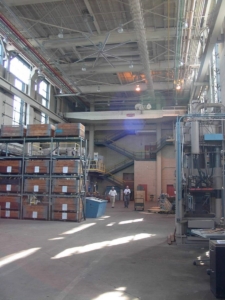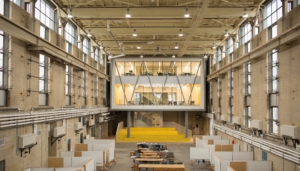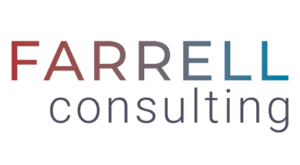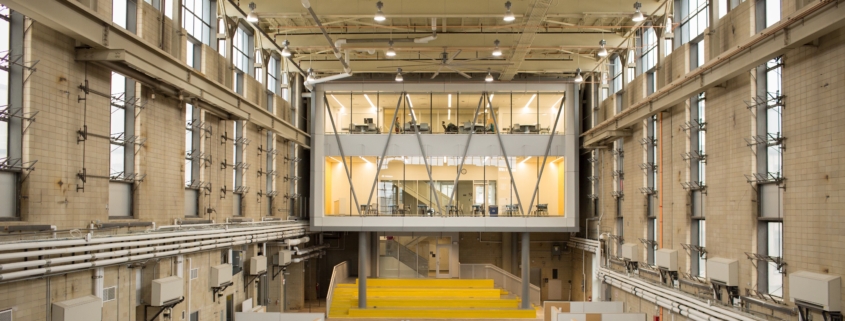Webinar Epilogue: Innovation Case Study
INTRODUCTION
Last month, Katherine Sanders and I offered a webinar about campus innovation. The case we looked at was one in which a large abandoned industrial building became available for Lehigh University to purchase and how we might use elements of transparent communication (the topic of our webinar) in gathering input, making a decision, and taking supporting actions afterward. At the end of the webinar, participants asked questions so I thought I’d share some of the highlights of this multi-year campus innovation.
BACKGROUND
I used this experience as a case study because I see it as an example of the ongoing process of campus-wide innovation. Opportunities like this one are rare. There are usually some early indications of what might happen (it was not a surprise that the building was available), allowing for advance thinking about how to proceed, what else might happen in parallel or in sequence, and what has happened in the past that would help or hinder this situation.
In this case, the campus had an opportunity to buy a disused industrial building. In reality, there were two buildings that had been unused for several years by their owners. While they were listed ‘for sale’, location and zoning restrictions would make it virtually impossible for any industrial buyer, so they languished. Deep in the language transmitting ownership of the buildings from the bankrupt Bethlehem Steel (ca. 2000) to the new owners was a caveat that in 20 years or so, ownership would pass to Lehigh University. So, if leadership did nothing, eventually campus would own these buildings, presumably at little or no cost.

The building soon after the acquisition.
The buildings were large shop-type spaces with some office spaces. The larger of the two has three large bays, each about 200 feet long, 75 feet wide, and 50 feet high, with no beams or uprights to block the space. The smaller building has a large shop space of about 200 ft by 100 ft, along with some office spaces.
The owners had turned off the heat (to save money and because they didn’t want to fix steam leaks), electricity, and water. Unheated buildings decay rapidly, and if we had waited the additional 8 years or so (plus a few years for lawyers to wrangle) it’s likely they would have had to be torn down, as they would not have been usable or restorable.
WHAT WAS THE PROBLEM
So the actual situation was…should Lehigh go after the buildings when they had considerable life left in them, or wait and tear them down when ownership reverted to campus? The “buy now” choice would require some investment to make them usable. Not incidentally, it would be an assertive decision and choice of direction, rather than simply waiting.
At the same time, a number of senior leaders were discussing how we might enable some of the more creative of our faculty to explore different kinds of experiential learning. For some faculty, time and space were major limitations. I was wondering if this raw industrial building might relieve the space constraint. The VP for Research was one of the enthusiasts for this opportunity to creatively un-block experiential opportunities, so even as we were deciding to try to get the buildings, he took the lead to invite any and all faculty who had some ideas of how to use this space even in its rough form, to start meeting and hone in on a few ‘pilot’ things we might try.
THE RESULTS
A core group of faculty thought a good starting place, unconstrained by existing credit rules, might be to offer team-based experiential projects as summer courses. The core faculty group worked out most of the details, including that campus would offer a summer stipend for students. Student summer programs would mean students would have to forgo a summer job, and for some of our students, that’s not an option.
The negotiation with the building owners dragged out, but in the end, we got the keys to the buildings two weeks before the start of the planned summer session. We hurriedly cleaned out one wing of one of the new buildings, and installed wi-fi, but still had no potable water in the building. We also didn’t have time to clear some dubious items from the space, so we temporarily fenced them off. It was rough, but it was large. And the students and faculty were delighted with what felt like unlimited space and other unlimiting that open space might suggest.
The students and faculty’s enthusiasm with the space over the following two summers and the visibility among other universities, helped our Trustees see the value in further investment. Our goal was to make the space more usable, though still spare and industrial. That further investment, about $14 million, allowed renovation of the building infrastructure (plumbing, electrical, HVAC) and development of intentional creative spaces while maintaining the open, flexible, and experimental feel of the space.

Building three years later.
Since the renovation, two academic departments have moved in, both appreciating the value of the open space, and largely willing to deal with the inconvenience of a 10-minute bus ride from the central part of campus.
The case we discussed in the webinar represented a specific decision—to buy the building or not—in a short period of time. The purchase itself was reasonably quick, but the efforts to engage faculty and students, invite their creative thinking about what the spaces could be, convince Trustees and donors of the value of the significant investment, and actual implementation, took about 4 years.
The best use of the larger building is still a work in progress—and I hope it remains so into the future. We have tried to resist carving large spaces into small ones and assigning permanent ‘ownership’ of spaces to departments or other units. This element has been a real challenge, as some units can be rather parochial about ‘their’ space. An understanding of history helps a bit, as space ownership had rarely changed in the past, so a unit was incentivized to keep control of underutilized space knowing that if they gave that space up in the near term and needed that space in the future, they would never get it back. With a huge space slightly away from the central hub of campus, we could put some new space practices in play that might not be what folks were accustomed to, but might be accepted given the evolution and location of this space.
We hoped that this space would encourage experiential activity and become a normal part of most students’ Lehigh experience. We now have a small staff who partner with faculty to help them develop experiential ideas and integrate them into the curriculum, whether in this new space or in the traditional campus spaces.
In addition to the response of our students and faculty, the biggest compliment we have received has been imitation. Since our efforts with this purchase started in 2012, a number of other universities have called to find out how we did what we did. When I talk with them, we discuss how their efforts need to be tailored to their culture and environment, and how the symbolism as well as the reality of untraditional space can be energizing.
Innovation in the kind of spaces universities use and how we use them may seem small; however, if we want our students to be innovators themselves, I think they need to see that happening around them, and this Mountain Top effort was one example at Lehigh University.
FOR MORE INFORMATION
For more information on kindness in the workplace, join us for our next webinar Wednesday, Jan. 25 from 11:30 a.m. – Noon CDT. Registration information coming soon.





Leave a Reply
Want to join the discussion?Feel free to contribute!